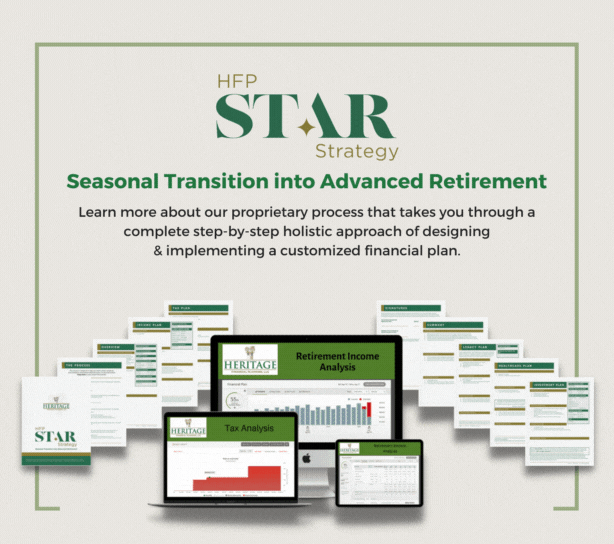As retirement approaches, ensuring your healthcare coverage aligns with your financial plan is critical. But with new changes coming to Medicare in 2025, it’s easy to feel overwhelmed and unsure how these updates may impact your prescriptions, your budget, and your peace of mind.
Imagine reaching retirement only to find that rising drug costs and coverage gaps have drained more of your savings than expected. Or being surprised by shifting Medicare Advantage benefits that leave you scrambling for affordable care. In today’s uncertain economy, these unexpected costs can erode your retirement income faster than you think.
This article breaks down the 2025 changes to Medicare Part D and Medicare Advantage plans, so you can make informed decisions and protect your retirement income. We’ll also look at how the current economic landscape could influence your retirement plan, and how our proprietary HFP S.T.A.R. Strategy can help you navigate these challenges confidently.
2025 Changes to Medicare: What’s New?
Medicare Part D – Lower Out-of-Pocket Costs
One of the most significant changes in 2025 is the introduction of a new $2,000 annual out-of-pocket cap for Medicare Part D prescription drug coverage. This is a welcome relief for retirees who have faced skyrocketing drug costs in recent years. Previously, there was no out-of-pocket maximum, leaving many seniors vulnerable to unlimited expenses.
Additionally, the catastrophic coverage phase has been eliminated. Once you reach the $2,000 spending cap, you’ll no longer have to pay a coinsurance percentage—Medicare will cover the remaining drug costs for the year. This shift brings much-needed financial certainty for retirees relying on expensive medications.
Medicare Advantage – Expanded Flexibility
Medicare Advantage (MA) plans are expected to continue evolving in 2025, offering expanded supplemental benefits. Many plans are enhancing their coverage for dental, vision, and hearing services. Some plans also provide greater flexibility for transportation and wellness services—benefits that help retirees stay healthier and more active.
However, these benefits can vary widely by plan and region, so it’s essential to review your MA plan during the Annual Enrollment Period. With the ongoing changes, a one-size-fits-all approach no longer applies; careful evaluation of your needs and plan options is more important than ever.
Economic Landscape in 2025: Implications for Retirees
While Medicare is expected to see positive changes in 2025, the broader economy presents some challenges for retirees and pre-retirees.
Inflation and Interest Rates
Inflation has moderated from its peaks in recent years, but prices for essential goods and services remain higher than before the pandemic. The Federal Reserve’s interest rate policy continues to play a balancing act between managing inflation and supporting economic growth. As of mid-2025, rates have remained elevated, meaning higher borrowing costs but also higher yields for conservative savers.
Market Volatility and Retirement Income
Market volatility is another concern for retirees drawing down their investments for income. While higher interest rates have improved yields on savings and fixed-income investments, they also create uncertainty in the stock market, where many retirees hold a significant portion of their wealth.
This environment requires a careful balance: while you may enjoy better returns on savings accounts and bonds, market volatility and inflation can still erode purchasing power if not managed properly.
What This Means for Your Retirement Plan
The combination of Medicare updates and economic headwinds means retirees must remain proactive. Here’s what to consider:
✅ Review Your Medicare Plan: The new $2,000 out-of-pocket cap in Part D is a great opportunity to save on prescription costs. Ensure your drug plan aligns with your medications and that you’re not paying more than necessary.
✅ Revisit Your Asset Allocation: With market volatility and inflation risks, it’s crucial to have a diversified, balanced investment strategy that can weather short-term storms while still providing long-term growth.
✅ Plan for Longevity: As healthcare costs continue to rise, even with improved Medicare protections, retirees should plan for increasing medical expenses throughout retirement.
How We Can Help: The HFP S.T.A.R. Strategy
At Heritage Financial Planning, we understand the challenges and opportunities that come with navigating retirement in 2025. That’s why we developed the HFP S.T.A.R. (Seasonal Transition into Advanced Retirement) Strategy. This holistic approach adapts to changes such as those in Medicare, inflation, and market volatility, ensuring your retirement plan remains flexible, resilient, and aligned with your goals.
Let’s make sure these Medicare updates and economic shifts work for you, not against you. Contact our office today to schedule a personalized review of your retirement plan and see how the HFP S.T.A.R. Strategy can help you thrive.
 Click here to learn more about our HFP STAR Strategy process.
Click here to learn more about our HFP STAR Strategy process.
Sources:
-
Centers for Medicare & Medicaid Services. “Medicare 2025 Part D Changes.” CMS.gov, 2025. https://www.cms.gov
-
KFF (Kaiser Family Foundation). “Key Changes to Medicare in 2025: What Beneficiaries Need to Know.” KFF.org, April 2025. https://www.kff.org
-
Social Security Administration. “Cost-of-Living Adjustment (COLA) Information for 2025.” SSA.gov, 2025. https://www.ssa.gov/cola
-
Federal Reserve Board. “Monetary Policy Report – June 2025.” FederalReserve.gov, June 2025. https://www.federalreserve.gov/monetarypolicy
-
U.S. Bureau of Labor Statistics. “Consumer Price Index Summary.” BLS.gov, May 2025. https://www.bls.gov/news.release/cpi.nr0.htm












